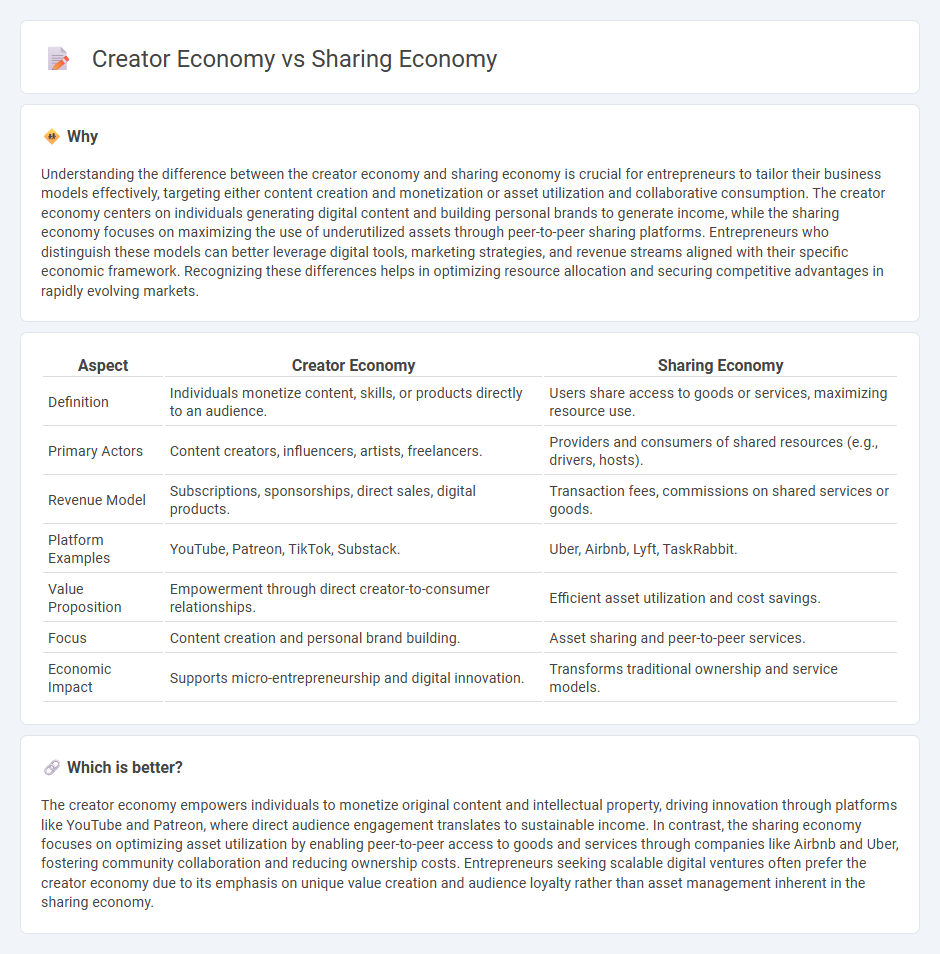
The creator economy empowers individuals to monetize personal content, fostering innovation through direct audience engagement on platforms like YouTube and Patreon. In contrast, the sharing economy leverages underutilized assets, such as housing or vehicles, enabling access over ownership via services like Airbnb and Uber. Explore the nuances of these emerging economic models to understand their impact on modern entrepreneurship.
Why it is important
Understanding the difference between the creator economy and sharing economy is crucial for entrepreneurs to tailor their business models effectively, targeting either content creation and monetization or asset utilization and collaborative consumption. The creator economy centers on individuals generating digital content and building personal brands to generate income, while the sharing economy focuses on maximizing the use of underutilized assets through peer-to-peer sharing platforms. Entrepreneurs who distinguish these models can better leverage digital tools, marketing strategies, and revenue streams aligned with their specific economic framework. Recognizing these differences helps in optimizing resource allocation and securing competitive advantages in rapidly evolving markets.
Comparison Table
| Aspect | Creator Economy | Sharing Economy |
|---|---|---|
| Definition | Individuals monetize content, skills, or products directly to an audience. | Users share access to goods or services, maximizing resource use. |
| Primary Actors | Content creators, influencers, artists, freelancers. | Providers and consumers of shared resources (e.g., drivers, hosts). |
| Revenue Model | Subscriptions, sponsorships, direct sales, digital products. | Transaction fees, commissions on shared services or goods. |
| Platform Examples | YouTube, Patreon, TikTok, Substack. | Uber, Airbnb, Lyft, TaskRabbit. |
| Value Proposition | Empowerment through direct creator-to-consumer relationships. | Efficient asset utilization and cost savings. |
| Focus | Content creation and personal brand building. | Asset sharing and peer-to-peer services. |
| Economic Impact | Supports micro-entrepreneurship and digital innovation. | Transforms traditional ownership and service models. |
Which is better?
The creator economy empowers individuals to monetize original content and intellectual property, driving innovation through platforms like YouTube and Patreon, where direct audience engagement translates to sustainable income. In contrast, the sharing economy focuses on optimizing asset utilization by enabling peer-to-peer access to goods and services through companies like Airbnb and Uber, fostering community collaboration and reducing ownership costs. Entrepreneurs seeking scalable digital ventures often prefer the creator economy due to its emphasis on unique value creation and audience loyalty rather than asset management inherent in the sharing economy.
Connection
The creator economy thrives on individual content creators monetizing digital assets, while the sharing economy emphasizes collaborative consumption of goods and services. Both economies leverage digital platforms to facilitate peer-to-peer interactions, enabling resource optimization and income generation. This convergence fosters innovative business models where creators share intellectual property and assets, driving economic growth through community engagement and decentralization.
Key Terms
Peer-to-peer (Sharing economy)
Peer-to-peer sharing in the sharing economy enables individuals to exchange goods, services, or assets directly, leveraging platforms like Airbnb and Uber to optimize resource utilization and reduce costs. This model fosters trust through user reviews and ratings, enhancing transparency and community engagement. Explore the distinct dynamics and growth drivers of peer-to-peer exchanges compared to creator-driven content monetization.
Monetization platforms (Creator economy)
Monetization platforms in the creator economy, such as Patreon, OnlyFans, and Substack, empower individual creators to directly earn revenue through subscriptions, donations, and exclusive content sales. Unlike the sharing economy, which monetizes underutilized assets like Airbnb and Uber, creator economy platforms focus on personal brand development and content monetization. Explore how these platforms revolutionize income streams for content creators and influence digital entrepreneurship.
Asset utilization (Sharing economy)
The sharing economy maximizes asset utilization by enabling peer-to-peer access to underused resources such as homes, cars, and tools, thereby reducing waste and increasing efficiency. Platforms like Airbnb and Uber exemplify how shared asset access creates value without ownership transfer, promoting sustainability and cost savings. Explore further to understand how asset utilization drives innovation in the sharing economy.
Source and External Links
What Is the Sharing Economy - Example Companies, Definition ... - The sharing economy is a flexible economic network allowing people to exchange tangible and intangible resources at scale, often reducing transactional friction and creating opportunities to use idle possessions or talents more efficiently through technology such as the internet.
Sharing Economy - Definition, Model, Pros and Cons - The sharing economy is an economic model where physical assets become services shared collaboratively among individuals and groups, enabled by big data and online platforms, facilitating monetization of underused resources such as cars or spare rooms.
Sharing economy - Wikipedia - The sharing economy is a socio-economic system where consumers share in the creation, trade, and consumption of goods and services, providing access without ownership, improving service quality through rating systems, and offering community and economic benefits.
 dowidth.com
dowidth.com